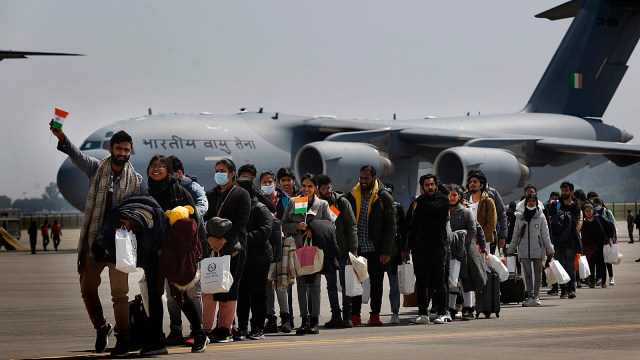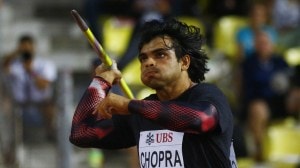- India
- International
India’s present place in the world: How Gen Z can keep the flag flying
In India, cultural and religious continuity remains strong, for now. But if we look at the larger picture, it seems a break from this trend is near, unless abated with better education
 Students fleeing the Ukraine war arrive at the Hindan Airbase in Ghaziabad on Friday. (Express File Photo by Praveen Khanna)
Students fleeing the Ukraine war arrive at the Hindan Airbase in Ghaziabad on Friday. (Express File Photo by Praveen Khanna)At the heart of External Affairs Minister S Jaishankar’s new book, Why Bharat Matters, is the idea that in Prime Minister Modi’s vision of Bharat, people matter.
From rescue operations for Indian students and workers stranded abroad by wars and pandemics to dealing with multiple foreign actors in order to get the necessary supplies for the production of vaccines for a billion people (and then some friends abroad), there is no dearth of examples from Jaishankar’s ministry alone.
Taking India to the curious
The goal of the book is more than a mere recollection of achievements. It is an attempt to tell the reader that the world outside India is not magically just a passport, visa and ticket away. The safety, bargaining power, image, reputation, and the kind of experience an Indian worker, student, entrepreneur or tourist might have in today’s world depend a lot on the kind of work that Jaishankar and his team do. This point is clearly made in a chapter titled ‘Foreign Policy and You’.
I suspect, perhaps because of my own biases as an educator, that Jaishankar is concerned about taking the conversation on foreign policy beyond the world of its practitioners and experts to anyone curious about how things in the world beyond India will affect them; especially to India’s massive population of youngsters, members of the global “Gen Z” (born roughly between 1995-2010) and some “Millennials” (under 40s, born between 1980-1994).
Generational dynamics are important. After all, about half of American youth between the ages of 18 and 35 have crossed a profound cognitive horizon in terms of how humanity understands crime and violence by declaring that they considered the atrocity-laden October 7 Hamas attacks on Israelis “justified.”

Indian youth, on the other hand, do not seem to have lost sight of terrorism and its promotion by foreign powers as a serious concern. Perhaps avoiding TikTok helped ensure the digital, and ultimately, psychological safety of young Indians more than we will know.
It is not just the morality of violence in question in America now but indeed its own existence. Psychologist Jean Twenge notes that 25 per cent of Gen Z say that America’s founding fathers are villains, and 75 per cent believe in the dismantling of the American government.
In some ways, calls for such fervent breaks from the past are not new in the West. Be it the overthrowing of “pagan” ancestral traditions during the Christianisation of Europe, or the schisms in Christianity, or the secular political revolutions of the 19th and 20th centuries — it seems to happen a lot. But whether the West will recover as the West we knew and what it will mean for India is an open question. Unlike past trends in which young progressives became middle-aged conservatives as they grew up and had children, the present cohorts of young, Democrat-voting, Hamas-justifying youth are not expected to change much over their life course.
Continuity amidst change
In India, cultural and religious continuity remains strong, for now. But a look at the totality of the transnational communication environment in which India’s storied “youth dividend” is learning about the world, makes it clear that merely ducking one controversial social media app does not mitigate the bigger issue of propaganda.
Jaishankar refers several times in Why Bharat Matters (and his earlier book, The India Way) to the issue of narrative control, propaganda, and disinformation. “We cannot be impervious to the shaping of our image,” he writes, “(s)ince so much in security derives from perception.”
Hard work can come undone
On that front, the period from 2014-2024 has been very costly, in my somewhat pessimistic view, to Bharat’s image. The young in the key institutions of generational intellectual reproduction in the West (and to some extent in India), millions of students, have received a very different view of what is happening in India. For supporters of India’s current government, it may seem obvious that much of the rhetoric in Western academia and media about Hindutva, or the caste system, or “democratic backsliding” is preposterously simple to not just debate but refute as well.
But for tens of thousands of second-generation children in school and college in America today — and of course, this is the same diaspora that both Jaishankar and Prime Minister Narendra Modi praise for their love of Bharat — the cesspool of lies and hate they face for being Hindu on campus every day is not easy to survive, let alone refute with befitting WhatsApp forwards.
Education makes for a very captive propaganda situation. In time, these children, the diaspora’s “Gen Z” too, will have no room left in life, career, or mental resilience, most of all, except to concur with the lies and then invest themselves wholly in defending them. In a worst-case scenario, the hard work India’s diplomats have done to de-legitimise terrorism will be undone when a new generation of eager South Asian Americans grows up and occupies positions of influence abroad (and that they are likely to do, considering how success-driven the community is). They will be the first to justify terrorism as “decolonisation” or confidently demand the guillotine for human beings they deem oppressors.
Early signs of this trend are already here. In multiple hearings about the alleged “universal exports” of the “caste system” by the Hindu diaspora, and more vividly in the pro-Hamas protests sweeping American cities, the Indian-origin products of a compromised American worldview are unfortunately at the forefront. If Bharat is to continue rising, it will have to recognise, study, and suitably invest in averting its narrative downfall. Political and economic influence without cultural legitimacy will not take us very far in this information age. Demonising the youth will not help. Educating them better will.
To conclude on a more optimistic note, though. It is worth coming back to Jaishankar’s observations. India is moving from being merely “influenced” by the world to becoming an influencer. That acquisition of agency, of course, will happen through not just economic growth, but generational and intergenerational learning as well. For now, the question of how we wish to influence the world remains open, considering that Bharat has not traditionally sought to influence others or its own into one rigid ideological direction.
Bharat in an unnatural world order
Bharat is rising into an unnatural world order shaped by competing, total-global propaganda mandates; be it the monotheisms of old imperialisms or the quasi-secular ideologies of more recent times.
As Jaishankar writes, in the colonial era, there was no room for any country except to be “a victim or an assailant: there was no middle ground” (p. 200). But India’s present course in the world is indeed uncharted territory.
As a friend recently put it, India is trying to do what no one has done for a while, which is to say that “the good guys can shape the world order too.” Not the “goody-goody” guys with all platitudes and no power like an earlier India, but with the strength of the sort that comes from Krishna and Hanuman and a vast traditional ocean of bhavas and mudras and ayudhas to meet the many faces of a multifaceted world; with everything — and everyone — that is Bharat.
The writer is professor of Media Studies, University of San Francisco
EXPRESS OPINION
More Explained
May 08: Latest News
- 01
- 02
- 03
- 04
- 05
































